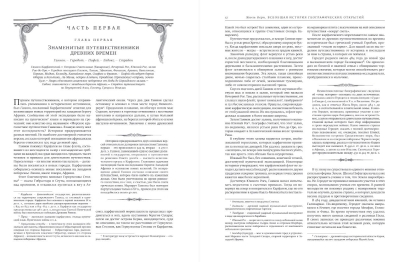General History of Geographical Discoveries
39.99 €
In stock
The name of the famous French writer Jules Verne needs no introduction. According to UNESCO statistics, his books rank second in the world in terms of the number of translations, second only to the works of Agatha Christie. The works of Jules Verne are considered unsurpassed, reference examples of classic adventure literature.
History of geographical discoveries in the presentation of Jules Verne enjoys well-deserved fame as one of the best publications on the history of humanity's exploration of the planet Earth. "The purpose of the book, - wrote Jules Verne about his work - to present in a true light the importance of all travelers, beginning with Gannon and Herodotus and ending with Livingstone and Stanley." To the realization of his favorite idea to write a serious, thorough and at the same time entertaining history writer went all his life: many years painstakingly accumulated factual material and long 10 years to write this work. Only such a tireless worker, as was Jules Verne, was able to thoroughly study historical and geographical sources, works of geographers, notes of travelers, diaries of expedition participants, materials of state archives. In a fascinating and lively manner, Jules tells us how, since ancient times, the ideas of mankind about the Earth have been changing and how, over time, there were fewer and fewer "white spots" on the planet. The wealth of factual information, rigorous presentation of facts, thousands of geographical names, hundreds of discoverers from ancient times to modern times, diverse and extensive material, numerous illustrations made especially for this edition of the best French artists, geographical maps and drawings from ancient books and notes of travelers - all this made the release of Jules Verne's book the most important event in the cultural life of France in the late XIX century.
The first book, entitled The Discovery of the Earth, covers the period from the 6th century B.C. to the end of the 17th century. The reader will find here information about travelers of Ancient Greece and Rome, the Middle Ages and the Age of Great Discovery. The author tells in particular detail about the voyages of Marco Polo, Christopher Columbus, Vasco da Gama, Amerigo Vespucci, Fernan Magellan and other discoverers. The second book - "Navigators of the XVIII century" - is the story of the voyages of Cook, La Perouse, Pallas, Bering, Humboldt and others. The third book "Travelers of the XIX century" describes the expeditions of Kruzenstern, Kotzebue, Litke, Dumont-Durville, Bellingshausen, Wrangel and other remarkable discoverers. The modern edition is also accompanied by additional reference material.
History of geographical discoveries in the presentation of Jules Verne enjoys well-deserved fame as one of the best publications on the history of humanity's exploration of the planet Earth. "The purpose of the book, - wrote Jules Verne about his work - to present in a true light the importance of all travelers, beginning with Gannon and Herodotus and ending with Livingstone and Stanley." To the realization of his favorite idea to write a serious, thorough and at the same time entertaining history writer went all his life: many years painstakingly accumulated factual material and long 10 years to write this work. Only such a tireless worker, as was Jules Verne, was able to thoroughly study historical and geographical sources, works of geographers, notes of travelers, diaries of expedition participants, materials of state archives. In a fascinating and lively manner, Jules tells us how, since ancient times, the ideas of mankind about the Earth have been changing and how, over time, there were fewer and fewer "white spots" on the planet. The wealth of factual information, rigorous presentation of facts, thousands of geographical names, hundreds of discoverers from ancient times to modern times, diverse and extensive material, numerous illustrations made especially for this edition of the best French artists, geographical maps and drawings from ancient books and notes of travelers - all this made the release of Jules Verne's book the most important event in the cultural life of France in the late XIX century.
The first book, entitled The Discovery of the Earth, covers the period from the 6th century B.C. to the end of the 17th century. The reader will find here information about travelers of Ancient Greece and Rome, the Middle Ages and the Age of Great Discovery. The author tells in particular detail about the voyages of Marco Polo, Christopher Columbus, Vasco da Gama, Amerigo Vespucci, Fernan Magellan and other discoverers. The second book - "Navigators of the XVIII century" - is the story of the voyages of Cook, La Perouse, Pallas, Bering, Humboldt and others. The third book "Travelers of the XIX century" describes the expeditions of Kruzenstern, Kotzebue, Litke, Dumont-Durville, Bellingshausen, Wrangel and other remarkable discoverers. The modern edition is also accompanied by additional reference material.
See also:
- All books by the publisher
- All books by the author
- All books in the series General History













